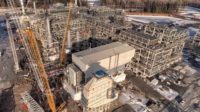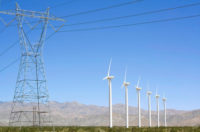Natural gas markets already are reacting to speculation that startup of the damaged Freeport liquefied natural gas export terminal in Texas, which accounts for 20% of American shipments and now about 10% to Europe, may be further delayed by federal regulators. The facility south of Galveston has been closed since a June 8 explosion and fire.
The U.S. Energy Information Administration on July 11 said the outlook for U.S. LNG exports fell by 6% since the incident, with the agency now projecting an average of 10.9 billion cu ft exported per day, down from 11.9 billion foreseen last month. But the agency predicts output could rise to an average of 12.7 billion cu ft per day when Freeport returns to full service in 2023, if the projected date holds.
Demand for U.S. feedgas has averaged around 12.17 billion cu ft per day this year up to July 13, 15.4% higher than the same period in 2021, says Platts Analytics, noting the added push from European markets squeezed by Russian gas supply cuts as a result of the Ukraine war.
The European Union voted earlier this month to designate natural gas and nuclear power as “environmentally sustainable” in its energy transition, despite environmental advocates' opposition and a longer-term goal to more broadly adopt renewable sources.
Freeport LNG said it expects to resume partial plant operation in early October and full production by the end of the year, but new federal conditions for reopening may delay that further, analysts speculate.
The U.S. Transportation Dept.’s Pipeline and Hazardous Materials Safety Administration on June 30 told the firm that, after a preliminary investigation, plant conditions require a proposed safety order with remedial actions. The company must hire an independent firm to evaluate LNG storage tank operations, control systems inspection and testing procedures and qualifications and training of certain workers.
“Continued operations of the export facility without corrective measures may pose an integrity risk to public safety, property or the environment,” the agency said.
Preliminary Probe
A Freeport LNG spokesperson told ENR it is following agency requirements but would not detail corrective measures being taken or whether contractors have been hired for any work.
Chicago Bridge & Iron Co. was prime contractor of the EPC consortium that built Freeport LNG’s three trains, completed in 2012. McDermott International Inc., which acquired CB&I in May 2018, declined comment earlier to ENR on whether it is working at the facility.
The Woodlands, Texas-based fire safety and risk consultant IFO Group LLC has been hired to conduct a root cause failure analysis of the explosion, with a draft report set to be released to the agency and to Freeport LNG in coming weeks.
The federal agency's preliminary review suggested that an isolated pressure safety valve created overpressure in 300 ft of vacuum insulated piping, it said. The piping burst and allowed LNG and methane to escape, which caused the explosion and fire.
The ruptured pipe had been used to transfer LNG around the facility’s storage area and is located along a rack that supports additional piping, power cables and equipment, the agency said, noting that “much of the other piping in the area was also damaged and will require repairs or replacement before LNG transfer operations can recommence.”
The explosion in a section that had been inspected several weeks earlier created a 450-ft-high fireball, according to a Bloomberg report of a filing it says was “briefly posted” July 11 on the Federal Energy Regulatory Commission website. A subequet ENR website review found no such filing.
The LNG export plant is within an ecologically sensitive area and near areas used by the public, the pipeline agency said. The U.S. Coast Guard issued an order that restricts all marine cargo operations until Freeport conducts a risk analysis on marine transfers.
Moving to Market
As Freeport works to restart operations, other LNG developers are ramping up efforts to fill the capacity gap.
The Coast Guard now is preparing an environmental impact statement for New Fortress Energy’s first offshore natural gas export deepwater port to be located in federal waters about 16 miles off the coast of Grand Isle, La. The project includes adding LNG gas treating and liquefaction units on fixed offshore platforms, which the developer claims would have capacity to export about 2.8 million tons of LNG per year.
New Fortress Energy said that its Fast LNG liquefaction design pairs the latest advancements in modular, midsize liquefaction technology with jack-up rigs or similar offshore infrastructure, which allows lower cost and faster deployment than current floating liquefaction vessels and onshore terminals. The modular LNG plants will cost about half of a traditional facility and could be built in 25% to 50% of the usual construction time, the firm said.
New Fortress awarded Fluor Corp. on July 11 an EPC contract of undisclosed amount for the Fast LNG 2 project phase. Fluor won an earlier phase of the project, Fast LNG 1, in the first quarter of the year. The developer hopes to have the first phase operating in early 2023. No target operating date was disclosed for the second plant.
The construction cost of the project also was not disclosed.
The design and execution plan allows “repeatable project modules” for future projects, said Jim Breuer, group president of Fluor’s Energy Solutions group, in a statement. The company added that the modular plant will be “available for dispatch to various locations around the world, allowing New Fortress Energy “to access multiple gas supply sources.”
Also aiming to ramp up in the Gulf of Mexico is the Delfin LNG Deepwater Port 40, to be located offshore of Cameron Parish, La. The U.S. arm of global energy trading firm Vitol announced a long-term LNG supply deal for 500,000 metric tons per year from the facility, the companies said July 13.
Delfin LNG was proposed in 2013 as a brownfield deepwater port to support up to four floating LNG vessels handling up to 13 million tons per year, supplied by the 42-in.-dia. UTOS pipeline, the largest-natural-gas line in the Gulf.
“Delfin has completed permitting work with a positive Record of Decision from the Maritime Administration," said Delfin COO Wouter Pastoor in a statement, adding that it has a U.S. Energy Dept. export license.
Samsung Heavy Industries and Black & Veatch have completed front-end engineering, “which puts us on pace to execute our project this year and to commence operations in 2026,” he said.
Delfin said it needs to finalize supply agreements with other customers to reach the 2 million to 2.5 million metric ton per year target needed to reach final investment decision and start construction later this year.
“Recent events have only accelerated the need for a wider array of potential buyers to source reliable low-cost energy from the safety of the US at compelling prices, and Delfin is perfectly positioned to serve this growing need,” said CEO Dudley Poston.







Post a comment to this article
Report Abusive Comment